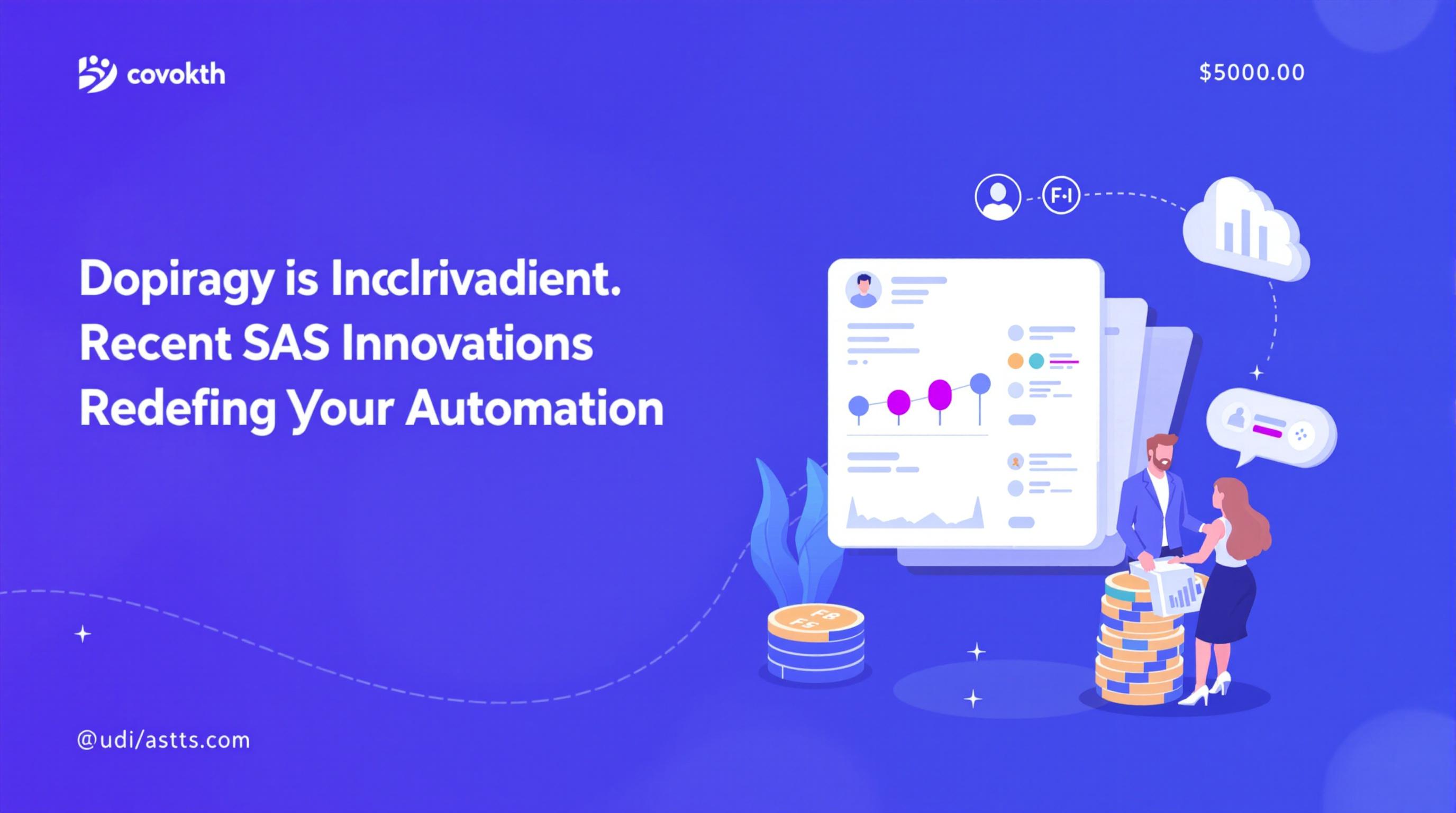Related Articles
- Top 8 Trailblazing Low-Code Platforms from the Past Five Years Revolutionizing App Development Efficiency
- Top 6 SaaS UX Innovations Since 2019 That Outsmart Legacy Giants in User Workflow Mastery
- How Forgotten Protocols in Legacy Systems Challenge Modern Digital Authentication Practices
- Unveiling the Role of Corporate Storytelling in Shaping Employee Adherence to Ethics and Compliance Standards
- 5 Next-Gen Digital Collaboration Apps from 2019-2024 That Transform How Teams Connect and Create
- The Unexpected Environmental Impact of Subscription Models: How Recurring Payments Influence Sustainable Consumer Choices
Top 9 Recent SaaS Innovations Redefining Payment Automation: Detailed Comparison and Expert Insights
Top 9 Recent SaaS Innovations Redefining Payment Automation: Detailed Comparison and Expert Insights
Top 9 Recent SaaS Innovations Redefining Payment Automation: Detailed Comparison and Expert Insights
Introduction to Payment Automation in SaaS
Payment automation has become a game-changer in the SaaS industry, enabling businesses to streamline billing, reduce manual errors, and enhance cash flow management. Recent innovations have focused on integrating artificial intelligence, machine learning, and better user experience (UX) to optimize payment journeys. According to a 2023 report by Gartner, over 70% of SaaS companies are adopting new automation tools to improve payment accuracy and reduce transaction times.
The evolution of payment automation spans several dimensions including real-time reconciliation, fraud detection, and predictive analytics. This article explores nine of the most promising SaaS innovations reshaping the payment ecosystem today, offering a detailed comparison and expert insights to guide decision-makers.
Each innovation is evaluated based on its functionality, integration capability, cost efficiency, and scalability. By understanding these advancements, businesses can make informed choices in selecting tools that not only automate payments but also provide strategic benefits for growth.
1. AI-Powered Payment Reconciliation
AI-powered reconciliation platforms leverage machine learning algorithms to match payments with invoices automatically, minimizing manual intervention. This technology significantly reduces the time needed to identify discrepancies and correct errors.
Innovations such as Tipalti’s AI engine and Botkeeper’s automated bookkeeping are exemplary in employing AI to predict and flag inconsistencies in payment flows. By analyzing historical data, these systems improve accuracy over time.
Experts note that adopting AI for reconciliation not only accelerates processes but also enhances compliance by ensuring all transactions are accurately documented. However, businesses must consider the initial training period for AI models to settle before realizing full benefits.
2. Blockchain Integration for Payment Transparency
Recent SaaS innovations incorporate blockchain to bring transparency and security to payment automation. Blockchain’s decentralized ledger records each transaction immutably, facilitating trust and auditability.
Platforms like Veem and Circle have integrated blockchain technology to enable cross-border payments with reduced fees and faster settlement times. This integration also helps in combating fraud by providing traceable transaction records.
According to Deloitte’s 2024 blockchain survey, 40% of enterprises are exploring blockchain for financial processes. While promising, challenges include regulatory uncertainty and the complexity of integrating blockchain with legacy systems.
3. Intelligent Payment Routing
Intelligent payment routing uses algorithms to select optimal payment paths based on cost, speed, and reliability. This innovation helps businesses reduce transaction fees and improve payment success rates.
SaaS solutions such as Payoneer and Adyen employ multi-rail routing strategies that dynamically adjust payment flows. These systems evaluate real-time data to switch between networks or banks efficiently.
Industry experts highlight that intelligent routing not only improves operational efficiency but also enhances customer satisfaction by minimizing failed payments. Companies need to evaluate vendor capabilities to ensure compatibility with their payment corridors.
4. Embedded Payments within SaaS Platforms
Embedded payments allow businesses to offer seamless in-app payment experiences, reducing friction for end-users. This trend enables platforms to control the payment process without redirecting customers to external sites.
Stripe and PayPal have expanded their APIs to support embedded payment processing within SaaS dashboards, thereby simplifying user experiences and accelerating payment cycles. These integrations also support subscription management and recurring billing.
Experts suggest that embedded payments are particularly valuable for SaaS companies looking to enhance UX and increase customer retention. Still, they recommend addressing security protocols comprehensively to protect sensitive payment data.
5. Subscription Billing Automation with Dynamic Pricing
Subscription billing automation has evolved to include dynamic pricing models that adjust costs based on usage, contract tenure, or customer segmentation. This approach offers more personalized billing solutions.
Tools like Chargebee and Zuora provide extensive automation in managing subscriptions and pricing changes without manual input, allowing for flexible plans and promotional offers. These SaaS tools also generate detailed analytics on customer payment behavior.
According to McKinsey, companies that adopt dynamic pricing models improve revenue by up to 15%. However, implementing these models requires clear communication to customers to avoid confusion related to fluctuating charges.
6. Real-Time Fraud Detection and Prevention
Top SaaS providers are implementing real-time fraud detection systems powered by AI and behavioral analytics. These systems monitor transaction anomalies to prevent fraudulent activities instantaneously.
Solutions like Sift and Forter use adaptive machine learning models that continuously learn fraudulent patterns, enabling rapid responses and reducing chargebacks. Integration with payment gateways ensures smooth user authentication without added friction.
Experts caution that balancing security and user experience is paramount. Fraud detection systems must minimize false positives to avoid disrupting legitimate transactions, which requires ongoing tuning and data quality management.
7. API-First Payment Platforms for Customization
API-first payment platforms focus on enabling businesses to design customized payment flows tailored to specific industry needs and workflows. This architectural approach supports greater flexibility and rapid innovation.
Notable platforms such as Plaid and Square offer robust APIs that allow developers to embed payment capabilities seamlessly within SaaS environments. Comprehensive documentation and developer support accelerate implementation.
Industry analysts emphasize that API-first platforms facilitate faster time-to-market and better integration with existing software stacks, making them highly attractive for SaaS providers looking to differentiate their offerings.
8. Automated Compliance and Tax Management
New SaaS innovations integrate automated compliance checks and tax calculations into payment workflows, ensuring adherence to regional regulations and simplifying audits. This reduces the complexity of cross-border transactions.
TaxJar and Avalara are leading solutions providing real-time sales tax calculations and filing automation within payment automation systems. These tools support multi-jurisdictional taxes and help reduce risks of financial penalties.
Experts point out that automation in tax and compliance reduces administrative overhead but requires continual updates to regulatory rules. SaaS providers should prioritize vendors that maintain regulatory databases rigorously.
9. Enhanced Analytics and Predictive Insights for Payments
Advanced analytics platforms are now incorporated in payment automation SaaS tools, offering predictive insights on cash flow, payment defaults, and customer behaviors. This evolution aids strategic financial planning.
Companies like Stessa and FIS Amplify provide dashboards and AI-driven forecasts that help CFOs and controllers optimize working capital and anticipate risks proactively. These insights are crucial in volatile economic conditions.
According to Forrester Research, data-driven payment automation leads to 20% better decision-making accuracy. Organizations are encouraged to leverage these tools to gain competitive advantage through informed financial management.
Conclusion: Choosing the Right Payment Automation Innovation
The diverse landscape of recent SaaS innovations in payment automation empowers businesses to address various payment challenges from reconciliation to fraud prevention and compliance. Selecting the right combination depends on business size, industry, and growth plans.
Experts recommend conducting detailed needs assessments and pilot testing before full-scale implementation. Integrating AI, blockchain, and APIs can lead to significant operational efficiency and better customer experiences.
As payment automation continues to evolve, staying informed about these advancements will allow businesses to maintain agility and competitive edge in their financial operations. Leveraging expert insights and comparative analyses helps ensure investments deliver optimal returns.




